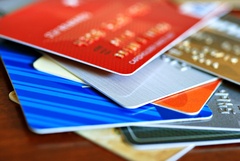Credit card debt is still high even as some claim the recession might be over.
For the recession-weathered consumer good news may be on the horizon. According to Credit Karma, consumer debt decreased in July 2009.
That’s not to say everything is looking up. Foreclosures are on the rise, the unemployment rate is up and consumer sales are down. But when we look at how these statistics are all connected the good news really is good.
From April 2009 until this July, Credit Karma reports an increase in credit scores across the entire nation.
The consumer advocate group Credit Karma released its U.S. Credit Score Climate Report for July 2009 and the report showed:
* 37 percent of credit scores have gone up
* while 28 percent have gone down
* and 35 percent of credit scores have remained the same.
That means that almost three quarters of Americans are either improving their credit scores, or keeping them stable.
And more good news, consumer debt decreased, too as consumers are continuing to pay down credit card debt, student loans and auto loans.
It seems like people are starting to get smarter with their money and protect the assets they have left, so it’s no wonder that consumer sales are down. People are pinching in the purse strings, and it shows.
U.S. retail sales fell 0.1 percent in July. According to the Commerce Department this drop marks the first decline in seasonally adjusted sales in three months.
Retail sales are down 8.3 percent on a year to year basis compared with July 2008.
It makes sense though, why would people being buying new things when they have debt to pay back and unemployment is on the rise?
The unemployment rate is currently holding at 9.4, but is predicted to reach 10 percent before dipping more drastically.
As more people lose their jobs, more people are also losing their homes.
RealtyTrac released its July 2009 U.S. Foreclosure Market Report, the biggest takeaway from that report: foreclosure rates for July are up 7 percent since June. Foreclosures have also increased 32 percent from a year ago.
“July marks the third time in the last five months where we’ve seen a new record set for foreclosure activity,” said James J. Saccacio, chief executive officer of RealtyTrac. “Despite continued efforts by the federal government and state governments to patch together a safety net for distressed homeowners, we’re seeing significant growth in both the initial notices of default and in the bank repossessions.”
Nevada tops out the list owning the nation’s highest foreclosure rate for the 31st consecutive month. Foreclosures in that state are more than six times the national average.
California, Arizona, Florida and Utah round out the top five states for foreclosure, and Idaho, Georgia, Illinois, Colorado and Oregon complete the top ten.
Not everything is bouncing back yet, but a decrease in consumer credit card debt is a significant step.
Learn more about credit scores from our Credit Score Topic Page and from our Credit Card Debt Topic Page.







Leave A Comment